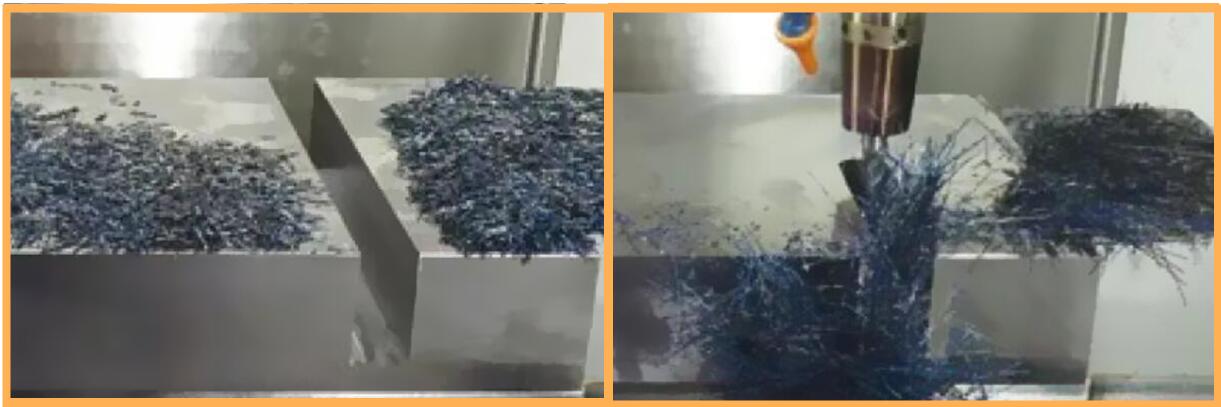PCD tool is a super hard tool widely used in metal cutting. PCD tool has better performance indicators, so fast tool heat transfers can significantly reduce the cutting force, small thermal deformation, and high machining accuracy. The PCD milling cutter is one of them; the PCD processing range is extensive and can process non-ferrous and non-metallic materials at the same time; PCD spiral milling cutter using a spiral blade, can reduce the tool wear in the rotary application, can also obtain faster cutting speed and longer tool life. Whether using PCD or other tools, PCD or other cutting tools all produce chips, and cutting different materials has different types.

Types and classification of chips
Because the workpiece material is different, the degree of deformation in the cutting process is different, resulting in many chip types, as shown below. From left to right, the first three parts are for cutting plastic body chips, and the last is for cutting fragile materials. The type of cutting process depends on the stress-strain characteristics and the degree of plastic deformation.
1. Strip chips.
The inner wall is smooth, and the outer layer is fuzzy. This type of chip usually appears in machining plastic metal materials such as carbon steel, alloy steel, copper, and aluminum alloy when the cutting thickness is small, the cutting speed is high, and the tool front Angle is large. Its cutting process balance and cutting force fluctuation are small; the machining surface roughness is minor.
2. Crush
This chip differs from a strip chip in that the outer surface is zigzag, and the inner surface sometimes appears cracked. Most of the chipping is done when the copper sheet is cutting; the cutting speed is slow, the cutting thickness is large, and the front angle of the tool will be longer.
3. Cell chips
When the cracks spread across the surface of the shear chip, the entire unit is cut away and becomes a trapezoidal unit chip, that will produce the type of chip when lead chips are cutting at very low speeds.
These three chips can only appear when working with plastic materials. In the cutting process, the cutting process of the strip chip is the most stable, and the cutting force fluctuation of the unit chip is the largest. Strip chips are the most common in the product, and sometimes squeeze chips can appear, but the unit chip is less.
If the conditions for extruding chips are changed, the unit chips can be obtained by reducing the front tool Angle, cutting speed, or cutting thickness. Instead, strip chips appear. So cutting conditions have a particular effect on chip morphology. Grasp its change law can control its deformation, shape, and size to achieve the purpose of rolling debris
4.Fragmentation
Fragile materials such as cast iron, brass, and other fragile materials process some chips; this kind of chip shape is irregular, processing surface is convex.
The results show that chip deformation is minimal during the cutting process, which is inconsistent with the chip formation mechanism of plastic materials. The brittleness is mainly due to the stress that the material undergoes beyond its tensile limit. The processing of high silicon cast iron, white iron, and other hard materials, especially in the case of large cutting thickness, often produce such chips.
Because its cutting process is precarious, it is easy to damage the tool, but also cause damage to the machine tool, has been processed surface and rough, and should try to avoid production. Reduce the cutting thickness so that the chip forms the needle or sheet, and improve the cutting speed appropriately to increase the workpiece material's plasticity.
The above four types of chips are representative, but the chip shapes obtained at the processing site vary. PCD spiral milling cutter chip also has a variety of forms.
Chip control measures
At present, cutting speed and metal cutting rate are very high, and cutting conditions are terrible, often producing many "unacceptable" chips.Chip control (also known as chip treatment), commonly referred to as "chip removal" in the factory, refers to the appropriate measures taken during the cutting process to control the curling, flow, and fracture of chips to an "acceptable" good chip shape.
In practice, grinding on the front cutter face of a PCD spiral milling cutter or other tools, or using block chip grinding, is the most widely used cutting control method.The above is a PCD spiral milling cutter and other cutting tools chip type and chip control measures; sincerely hope to help you.
Contact: Nina Qiao
Phone: 86-13526572721
E-mail: cutting@zy-superhardtools.com
Whatsapp:86-13526572721
Add: AUX Industry,Zhengzhou City,Henan Province,China
We chat
